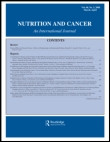
Eicosapentaenoic and docosahexaenoic acid supplementation in breast cancer patients

Eicosapentaenoic and docosahexaenoic acid supplementation in breast cancer patients
High-dose eicosapentaenoic acid and docosahexaenoic acid supplementation reduces bone resorption in postmenopausal breast cancer survivors on aromatase inhibitors: a pilot study
Nutr Cancer. 2014;66(1):68-76. doi: 10.1080/01635581.2014.847964. Epub 2013 Nov 25Did you know you're eligible to earn 0.5 CME credits for reading this report? Click Here
Synopsis
38 postmenopausal women being treated with aromatase inhibitors for breast cancer were randomized in this trial to determine the effect of eicosapentaenoic acid (EPA) and docosahexaenoic acid (DHA) on bone turnover and resorption. Participants were treated with capsules of either EPA+DHA or placebo (7 capsules/day) for 3 months, after which they were analyzed for serum fatty acid composition, biom...
To view the full content, login to your account,
or start your 30-day FREE Trial today.
FREE TRIAL
LOGIN
Forgot Password?
Explore some of our unlocked ACE Reports below!

Learn about our AI Driven
High Impact Search Feature
Our AI driven High Impact metric calculates the impact an article will have by considering both the publishing journal and the content of the article itself. Built using the latest advances in natural language processing, OE High Impact predicts an article’s future number of citations better than impact factor alone.
Continue



 LOGIN
LOGIN

Join the Conversation
Please Login or Join to leave comments.